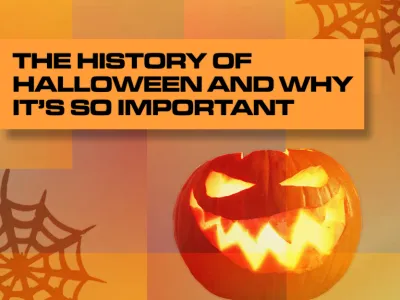
The Origins Of May Day: A Deeper Insight Into Beltane
Include this article in your Skills Builder Journal. It could help you develop... 
As we begin to enter the summer months, we come across the celebration of Beltane, an ancient Celtic fire festival celebrated by pagans (and others) all over the world on 1 May. Others may celebrate Beltane over three days, from 30 April to 2 May. You may also recognise this holiday by the name May Day!
Beltane is the celebration of the beginning of spring, falling between the winter solstice and spring equinox. It represents new life, new beginnings, fertility, love, union, sex and sexuality, abundance and light. During Beltane, the energies of the earth are at their most potent, bursting with life and growth, encompassing the world with floral and faunal beauty all around. The name ‘Beltane’ is thought to derive from the phrase ‘Bel’s fire’, which refers to the Sun God, Bel. However, a literal translation of the phrase means ‘bright fire’ (Grimassi, 40), indicative of the bonfires that play a colossal part of this festival, as well as the fire that represents the passion within and the new, burning light of summer yet to shine on us once more.

Beltane is the second of the four quarter fire festivals which fall at each seasonal turning point of the year. They are Imbolc, Beltane, Lughnasadh/Lammas and Samhain. Beltane and Samhain are seen as festivals representing masculine energies of the year, and Imbolc and Lammas represent the feminine. Many pagans and followers of the Celtic year and wheel of the year may see the year as divided into two halves of light and dark, and two primary seasons of winter and summer. Samhain is the beginning of the dark half of the year, and Beltane begins the light half. Sometimes Beltane is referred to as Cetsamhain, which means ‘opposite Samhain’, which reflects the two festivals living on opposite sides on the wheel of the year - Beltane being Samhain’s counterpart.
Traditionally, a Beltane bonfire would be lit by a druid, which is in honour of the god Bel, also known as Beli, Balar, Balor or Belenus. On Beltane eve, two large fires were built by the Celts, using the nine sacred woods based on the first nine trees in the Celtic tree calendar; birch, rowan, ash, alder, willow, hawthorn, oak, holly and hazel. Fire in this holiday was regarded as a source of healing, protection, and purification, which led to traditions like members of the community walking around, or jumping/dancing over the bonfires to cleanse themselves and bring upon new and fertile beginnings to their lives.
Young people leaped over the fire in hopes of attracting a partner, and couples jumped through together to pledge their devotion to one another. Others did so for protection on their travels, and pregnant women jumped over the fire to bless themselves with a swift and healthy delivery. Farmers would also drive their cattle between the bonfires to purify and cleanse them before they were led onto the fields to graze. People’s hearth fires would be relit with the flame of Beltane, signifying the collective share in honouring the Sun God and celebrating the beginning path to summer. Many villagers would do this by taking wood from the Beltane fires to use in their own hearths.
There is a legend which is widespread across the pagan community of the battle between the Holly and Oak Kings- who represent the dark and light halves of the year - for the love of the Goddess, also referred to as the May Queen. Beltane also mainly signifies the marriage, union and consummation between the God/King and Goddess/Queen, which is why Beltane is a widespread holiday known for weddings and handfastings all over the world.
Other traditions of Beltane included handfasting ceremonies, ‘jumping the broomstick’, going ‘A-Maying’, dancing around a maypole, and dressing trees.

Handfasting has a great essence, as it represents devotion to one another without the legality of being married by an institution. Many pagans decide to partake in this type of betrothal for ‘a year and a day’, or any length of time they choose - sometimes even for life. Many couples decide after this ‘year and a day’ to stay together or to part ways without any indictment. Handfasting includes exchanging vows, rings, and the actual handfasting of ‘tying the knot’. This is usually done by weaving a red string or ribbon around the couple’s hands together in an infinity symbol, which is later on unbound - signifying the decision to remain together of their own volition. During handfastings, ‘jumping the broom’ is a traditional act for couples to partake in. The literal jumping over a broom lying on the ground symbolises crossing the threshold together from an old life to a new life as newlyweds.
Going A-Maying was a tradition of young couples spending the night in the forest, woods and fields, meeting each other over this sacred night of unity and love. They could choose to enact the God and Goddesses act of sacred union, and if the two people paired by sundown, their courtship would continue with the opportunity to get married six weeks later on Midsummer’s Day. This is the origin of the sacred and traditional ‘June wedding’ which we value today!
To celebrate Beltane, Celts also used the joy of dancing to honour the sacred balance and union of the God and Goddess. The people would dance around a maypole - and tie bright and colourful ribbons around it, weaving them and symbolising the union between the sky and the earth, and the masculine and feminine. A ring of flowers at the top of the maypole represents the Goddess and her femininity and fertility. Dancing around the maypole has continued into our modern day traditions, usually seen in primary schools celebrating the beginning of May.
There are many other practices you can do to embrace and celebrate Beltane even if you are not pagan or identify with any religion. Some of the activities would require a certain level of optimistic superstition, but enjoying the fun of them is the most important aspect of embracing Beltane energy. One thing you may come across are trees with small colourful ribbons tied to them. This is called ‘dressing a tree’, with ribbons which represent wishes. If you have a tree in your garden or near you, you can bless a piece of ribbon or string and tie it outside, allowing the energies of Beltane to extend your wish into fruition. It is also a known tradition to wake up very early and collect the morning dew from flowers and plants on Beltane morn, and wash your face with it to bless yourself with long lasting beauty, protection, and purification for the next year. Another thing you can do is create a small Beltane altar to display in your house or bedroom, gathering elements such as flowers, branches, dew, acorns, leaves and seeds and put them together to create a lovely personal representation of spring.
I hope you’ve learnt much more about our upcoming celebration and that you have taken inspiration to celebrate spring in a more unique and connected way than before.
Until next time…




